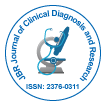Editorial Open Access
Medical Diagnostics Scenario in India
Kaushik Bharati*
Kaushik Bharati, Senior Program Officer, Translational Health Science and Technology Institute (THSTI), Gurgaon, Haryana, India
- Corresponding Author:
- Kaushik Bharati
Senior Program Officer
Translational Health Science and Technology Institute (THSTI)
Gurgaon, Haryana, India
Tel: 91-9910331170
Fax: 91-9910331170
E-mail: kaushik@thsti.res.in
Received date: November 11, 2013; Accepted date: November 11, 2013; Published date: November 15, 2013
Citation: Bharati K (2013) Medical Diagnostics Scenario in India. J Clin Diagn Res 1:e103. doi:10.4172/jcdr.1000e103
Copyright: © 2013 Bharati K. This is an open-access article distributed under the terms of the Creative Commons Attribution License, which permits unrestricted use, distribution, and reproduction in any medium, provided the original author and source are credited.
Visit for more related articles at JBR Journal of Clinical Diagnosis and Research
India is the largest democracy in the world. It is a country with varied cultures, cuisines, practices and religious beliefs. At the same time, it is a country that is making headways in the international scenario, largely due to its booming economy. India is attracting investments from across all sectors of the industry, mainly because of its intrinsic strength to grow from within rather than depend on exports.
The overall healthcare industry scenario can be said to be upbeat. It is directly influenced by the growing economy, new investment avenues, the high incidence of lifestyle disorders, and a large, talented and costeffective, young workforce, coupled with the large pool of experienced consultants. Importantly, the sectors that are benefitting the most are hospitals, pharmaceuticals, medical devices, diagnostics and associated pathological laboratories.
The Indian government, on its part is promoting the sector through positive regulations such as the introduction of the Health Bill, which aims to bring together independent bodies like the Medical Council of India (MCI), Dental Council of India (DCI), Pharmacy Council of India (PCI) and the Nursing Council of India (NCI) under one umbrella. The government is also increasing public expenditure in healthcare from just over 1% of the GDP to 2.5% of the GDP. It is also boosting other allied activities such as medical tourism to increase the revenue in the sector, as well as promoting private-public partnerships in the area of R and D, thereby making the overall atmosphere conducive to investments by foreign companies in the sector.
The Indian diagnostics sector has been witnessing immense progress. Major technological advancements and higher efficiency systems has taken the sector to new heights. Advanced cutting-edge technologies are being used to understand disease prognosis, thereby strengthening the sophistication level of the participants in the sector. Diagnostic medical imaging is one of the most rapidly growing fields in the Indian medical devices market. While nuclear imaging is the fastest growing area in the Indian imaging market, the diagnostic lab services are also growing at a fast pace, particularly in the unorganized sector. The segment’s growth is expected to be fuelled by the growing demand for automated diagnostics.
The Indian diagnostics market can be broadly divided into equipment, reagents and services. The service sector is largely unorganized, with the majority of players being clustered in the suburbs and metros. However a clear and structured format is being established in order to have better regulations and proper definition for the market. The size of the Indian in vitro Diagnostics (IVD) market is estimated to be 531 m USD in 2011; by 2016 it is expected to expand to approximately 900 m USD, growing at an annual growth rate of 18% (Frost and Sullivan). An important contributing factor towards this growth is the expansion of corporate hospitals. Moreover, non-communicable diseases such as diabetes are no longer diseases of the rich, and are spreading rapidly to rural areas. This is another contributory factor towards the growth. Therefore, with a compound annual growth rate (CAGR) of ~18%, IVD has emerged as one of the most profitable markets in the Indian healthcare industry. Importantly, in the coming years there will be likely increase in the number of health insurance policies. Therefore, more and more health insurance companies will coordinate with the various diagnostic labs.
Although many diagnostic tests are available for most diseases, still, many more are needed. For example, there is an urgent need for good and reliable diagnostics for many communicable diseases like tuberculosis, malaria, dengue, hepatitis B and C. For tuberculosis, a new test is available – the GeneXpert, which is a very good test and can even detect resistance. But even this is currently plagued by the high cost, which is preventing its introduction in the public health program in India.
Therefore, diagnostic tests not only need to be “available”, but they also need to be “affordable” and “accessible” in order to be able to make a real impact. It should be remembered that most of the people in urgent need of a diagnostic test are very poor, especially those in the developing countries. Therefore, innovative funding mechanisms need to be in place so that these tests can be made available to those who need them most. It should be remembered that if we miss the poor, we miss the point!
--Relevant Topics
- Back Pain Diagnosis
- Cardiovascular Diagnosis
- Clinical Diagnosis
- Clinical Echocardiography
- COPD Diagnosis
- Diabetes Diagnosis
- Diagnosis Methods
- Diagnosis of cancer
- Diagnosis of CNS
- Diagnosis of Diabetes
- Diagnostic Products
- Diagnostics Market Analysis
- Heart diagnosis
- Immuno Diagnosis
- Infertility Diagnosis
- Medical Diagnostic Tools
- Preimplementation Genetic Diagnosis
- Prenatal Diagnostics
- Ultrasonography
Recommended Journals
Article Tools
Article Usage
- Total views: 13761
- [From(publication date):
December-2013 - Jul 09, 2025] - Breakdown by view type
- HTML page views : 9238
- PDF downloads : 4523
